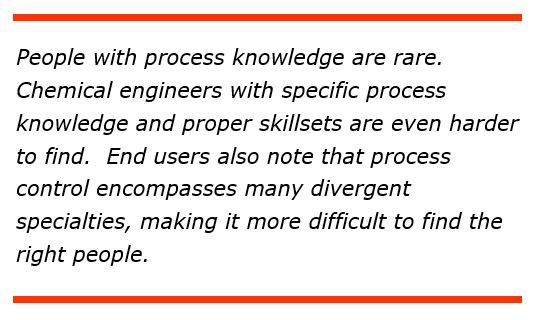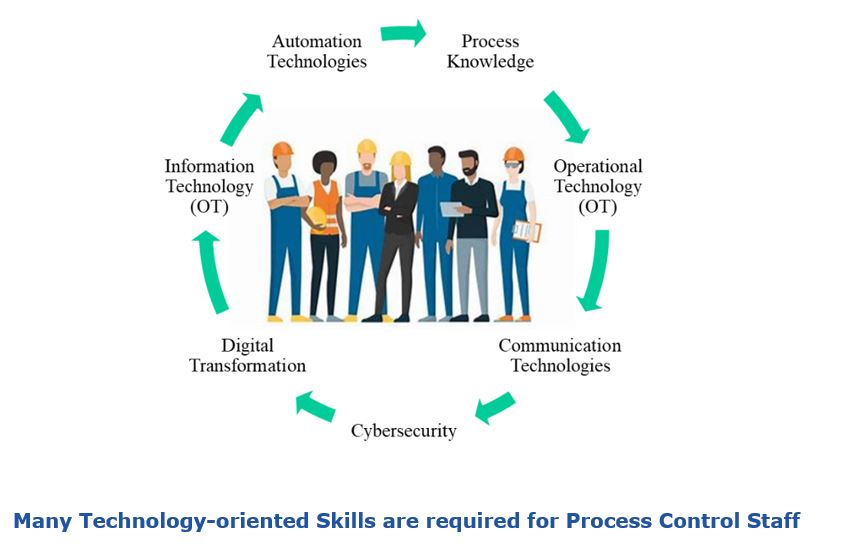

The process industries are challenged to continue to operate efficiently in an increasingly competitive environment. Technology is rapidly changing – brought on in large part by the era of digital transformation. Labor availability and skillset requirements are changing as well. Process control staffing for digital transformation requirements and personnel skillsets have evolved over decades of iterations.
Finding talent is a struggle. Most process manufacturing companies prefer chemical engineers as process control staff. However, universities do not appear to emphasize process control training. People with process knowledge are rare. Chemical engineers with specific process knowledge and proper skillsets are even 
Often it seems that management does not recognize that the organization needs this “digital” engineering skills as well “process” engineering training. Because the skillsets needed lead to operational siloes (even within the process control department), users are challenged on how to justify the seemingly extra staff needed to address these areas. Owner-operators often struggle with finding the best way to leverage people efficiently and acknowledged a need to identify transferable skillsets.
Another issue particularly prevalent today is dealing with cybersecurity, particularly since virtually all available cybersecurity professionals are already employed. The result is that process control engineers are pulled in all directions.

The design of a process control group must align with the overall production site culture, if not the entire corporate culture. As the organization has evolved over many years, the technology focused groups typically aligned with operational technology (OT) or information technology (IT). The question today is why do IT/OT have to be separate? Historically, these developed separeately because they focused in their own siloed approach to selecting, deploying and maintaining technology. Many orgainzations today need to figure out how they can create the right incentives and build trust so that these organizations can collaborate and evolve.
This topic is intriguing in the sense that HR personnel themselves have little personal experience with the needs of process control. Production management typically believe that potential new hires would prefer to work at Amazon, Alphabet, Uber, etc. instead of often-dirty, distant, and/or dangerous industrial facilities. ARC has noted in the past of the trailing off of hiring in the 1980s and 1990s that created an experience gap in the market. When you find experienced hires, there’s a culture clash between old and new companies.
Many have concluded that they have no long-range expectations for retention. For example, some companies use a rotation a fixed time frame for new engineers to help make the acceptance of an assignment at a less desirable site easier. Others may try recruiting engineers directly to plant site in small towns for a term of two to three years before possibility of going to corporate.
Another approach that some companies are trying is to get involved in high schools, interacting with students interested in engineering so they can discuss all the options, including tech school. A consistent presence of manufacturing companies at the schools of interest and those involved in the program should communicate the challenges and what excites them about the work.
If you hire locally, they may stay with the company longer term as their mobility may be constrained. Individuals that went away to college are potentially more mobile than those with ties to “home.”
It seems that everyone is going after the same relatively small pool of technically adept people. We heard one end user mention that of 100 potential hires, only 27 met the absolute minimum requirements for various reasons. That spawned a discussion of how a company could make itself more attractive. The other, perhaps more difficult approach and certainly longer term, is to increase the number of candidates that meet minimum requirements.
Many suppliers are positioning themselves as part of the solution to address the difficulty in maintaining process control staff. Many owner-operators have been using consultants to back fill positions and duties as a possible solution. Many end users are accustom to using supplier-provided services for system-level work, like patching and upgrades. Using suppliers or an engineering company also allows users to supplement staff in high-demand situations.
Of course using non-employ resources brings concerns of maintaining company standards and process control processes to minimize variability. These concerns basically center around contractor management. This is especially a problem for organizations in which key unit operations are not standardized within the corporate enterprise.
“Business as usual” has changed to “unusual.” The challenges are many and solutions are involved and arduous. The labor shortage is intensifying and companies are at various stages of coming to grips with the problem. Some see hope in new technology, but no one sees reduced dependence on humans in the future.
ARC has a large amount of best in class practices on this and other manufacturing-related topics. Through our Corporate Advisory Service for Industry Leaders programs, we can assist you in finding the best business approach for your operations. For further information or to provide feedback on this blog, please click on the “Contact Us” button below.

